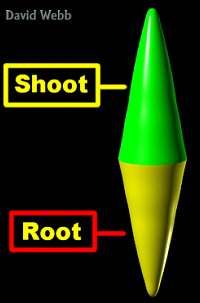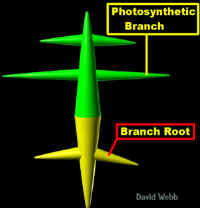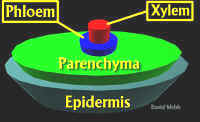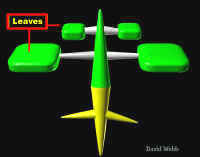
The first fossil land plants had horizontal and vertical shoots. They were either leafless or had minute leaves. One of these plants is called Rhynia.
The Psilophyta contains a genus Psilotum which closely resembles plants like Rhynia. It is essentially a stem that has two interconnected forms. The underground stem (Rhizome) produces Aerial Stems which are Photosynthetic. The Leaves are minute and contribute little to the plant's nutrition. The Rhizome produces Rhizoids which act like root hairs.
There is a debate concerning the
 Leaves of Psilotum.
They do not have Veins although Leaf Traces may diverge from the Stele and approach the
leaf bases. I think that they are leaves. If we assume that they had one Vein, they would
be Microphylls.
Leaves of Psilotum.
They do not have Veins although Leaf Traces may diverge from the Stele and approach the
leaf bases. I think that they are leaves. If we assume that they had one Vein, they would
be Microphylls.
The next step lead to the
evolution of distinct Shoots and Roots.
The shoots were specialized for Photosynthesis and the Roots were specialized for
absorption and anchorage. Root anatomy would not differ significantly from the cylindrical
Rhizome we saw earlier. Furthermore, Root Anatomy is very constant in Land Plants.
Branching occurred in the roots and produced a  complex root system.
complex root system.
Upright stems were able to overtop flat thalli and became dominant organisms. The production of photosynthetic branches further increased the surface area available for photosynthesis. Branching was initially Dichotomous for stems and roots. Lateral branching developed later in Evolution.
The ascent of aerial stems and
their branches required the development of superior support tissues. This was achieved
with the Psilophyta. Xylem Tracheary Elements have thick
walls and provide some structural support. However, Sclerenchyma (Scler = Hard) tissue
evolved and Sclerenchyma Fibers provided extra mechanical strength. Fibers are  found
in the Vascular Tissues or in close association with them. Sclerenchyma
and Parenchyma are the two principal Ground
Tissues.
found
in the Vascular Tissues or in close association with them. Sclerenchyma
and Parenchyma are the two principal Ground
Tissues.
The final step in the evolution
of our theoretical plant is the production of Leaves. These are highly specialized for
Photosynthesis in many ways. They usually have a wide thin Blade (Lamina) and a thicker
Midrib. They may have only one Vascular Bundle (Vein) or a network of interconnected
Veins. They are attached to the stem by a nonphotosynthetic petiole. 
The first Leaves were Microphylls and had one Vein/leaf. The vein had a central location and was surrounded by Photosynthetic Parenchyma.
The major functions of  the stem are translocation of water and photosynthate and structural
support for the leaves.
the stem are translocation of water and photosynthate and structural
support for the leaves.
Our theoretical plant has three distinct Organs (Leaf, Stem & Root).
Species in the Lycophyta illustrate simple plants that have Microphylls.